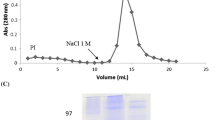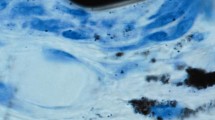Abstract
Auranofin (SK&F D-39162), a new antiarthritic gold compound reported to be orally effective in animal (adjuvant rat) and human (rheumatoid) arthritic conditions, is a potent in vitro inhibitor of the release of lysosomal enzymes from phagocytizing rat leukocytes. Auranofin, at micromolar concentrations (1–10μM), produced a dose-dependent reduction in extra-cellular levels of lysosomal enzyme markers (μ-glucuronidase and lysozyme) which are selectively released from rat leukocytes during phagocytosis of zymosan particles. The reduction in extracellular levels of lysosomal enzymes appears to be caused by inhibition of their selective cellular release, since effective concentrations of auranofin did not produce leukocyte cytotoxicity or inhibition of cell-free lysosomal enzyme activity. Morphologic and biochemical evidence indicated that auranofin also interferes with phagocytosis of zymosan particles. The potent in vitro activity of auranofin appears to result from its unique gold complex, since neither structurally related nongold compounds nor clinically used gold compounds (gold sodium thiomalate and gold thioglucose) were potent inhibitors of lysosomal enzyme release. The results of this investigation suggest that the antiarthritic activity of auranofin may be caused at least in part, by inhibition of lysosomal enzyme release and/or cellular processing of antigens.
Similar content being viewed by others
References
Sutton, B.M., E. McGusty, D.T. Walz, andM.J. DiMartino. 1972. Oral gold. Antiarthritic properties of alkyphosphine gold coordination complexes.J. Med. Chem. 15:1095.
Finkelstein, A.E., D.T. Walz, V. Batista, M. Mizraji, F. Roisman, andA. Misher. 1976. Auranofin. New oral gold compound for treatment of rheumatoid arthritis.Ann. Rheum. Dis. 35:251.
Berglöf, F.-E., K. Berglöf, andD.T. Walz. 1977. Auranofin: An oral chrysotherapeutic agent for the treatment of rheumatoid arthritis.Arthritis Rheum. 20:108.
DiMartino, M.J., D.T. Walz, C.E. Wolff, andW.A. Mann. 1974. Inhibition of lysosomal enzyme release from rat leukocytes by a new gold compound-SK&F D-39162.Fed. Proc. 33:558.
Walz, D.T., M.J. DiMartino, L.W. Chakrin, B.M. Sutton, andA. Misher. 1976. Antiarthritic properties and unique pharmacologic profile of a potential chrysotherapeutic agent: SK&F D-39162.J. Pharmacol. Exp. Ther. 197:142.
Persellin, R.H. 1968. Role of lysosomes in the pathogenesis of rheumatoid arthritis.Med. Clin. North Am. 52:635.
Chayen, J., andL. Bitensky. 1971. Lysosomal enzymes and inflammation.Ann. Rheum. Dis. 30:522.
Weissman, G. 1972. Lysosomal mechanisms of tissue injury in arthritis.N. Engl. J. Med. 286:141.
Henson, P. 1971. Immunologic release of constituents from neutrophil leukocytes. I. The role of antibody and complement on non-phagocytosable surfaces or phagocytosable particles.J. Immunol. 107:1535.
Walz, D.T., M.J. Dimartino, J.H. Kuch, andW. Zuccarello. 1971. Adjuvant-induced arthritis in rats. I. Temporal relationship of physiological, biochemical and hematological parameters.Proc. Soc. Exp. Biol. Med. 136:907.
Fishman, W.H., B. Springer, andR. Brunetti. 1948. Application of an improved glucuronidase assay method to the study of human bloodβ-glucuronidase.J. Biol. Chem. 173:449.
Amador, B., L.E. Dorfman, andW.E.C. Wacker. 1963. Serum lactic dehydrogenase. An analytical assessment of current assays.Clin. Chem. 9:391.
Baehner, R.L., andD.G. Nathan. 1968. Quantitative nitroblue tetrazolium test in chronic granulomatous disease.N. Engl. J. Med. 278:971.
Davies, P., R.I. Fox, M. Polyzonis, A.C. Allison, andA.D. Haswell. 1973. The inhibition of phagocytosis and facilitation of exocytosis in rabbit polymorphonuclear leukocytes by cytochalasin B.Lab. Invest. 28:16.
Zurier, R.B., S. Hoffstein, andG. Weissman. 1973. Cytochalasin B: Effect on lysosomal enzyme release from human leukocytes.Proc. Natl. Acad. Sci. 70:844.
Finkelstein, A.E., F.R. Roisman, andD.T. Walz. 1977. The effect of auranofin, a new antiarthritic agent, on immune complex-induced release of lysosomal enzymes from human leukocytes.Inflammation 2:143.
Author information
Authors and Affiliations
Additional information
SK&F D-39162 (2,3,4,6-tetra-O-acetyl-1-thio-β-D-glucopyranosato-S) (triethylphosphine) gold.
Rights and permissions
About this article
Cite this article
Dimartino, M.J., Walz, D.T. Inhibition of lysosomal enzyme release from rat leukocytes by auranofin. Inflammation 2, 131–142 (1977). https://doi.org/10.1007/BF00918675
Issue Date:
DOI: https://doi.org/10.1007/BF00918675




